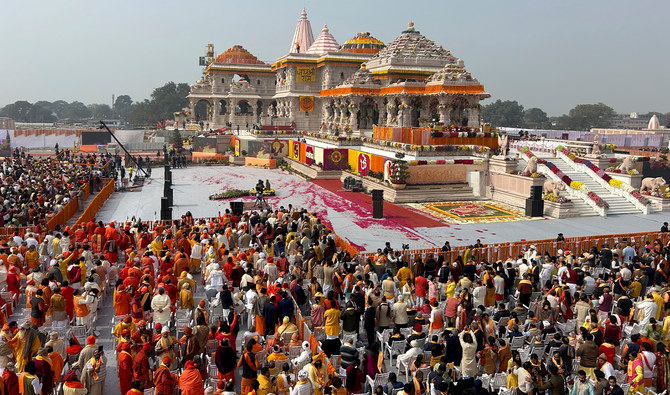Ayodhya, India: India’s Prime Minister Narendra Modi inaugurated a temple Monday that embodies the triumph of his muscular Hindu nationalist politics, galvanizing loyalists in an unofficial start to his re-election campaign this year.
Modi, in flowing golden-colored traditional dress, unveiled the black stone idol to the deity Ram in the heart of the 50-meter (160-foot) temple, built on grounds where a mosque stood for centuries before it was torn down in 1992 by Hindu zealots incited by members of his party.
That demolition triggered the worst religious riots since independence — killing 2,000 people, most of them Muslims — and shook the foundations of India’s officially secular political order.
Outside, tens of thousands of chanting and dancing devotees waving flags, honking horns and beating drums, packed the streets of the northern town of Ayodhya, as military helicopters showered flower petals from the sky.
Few members of Ayodhya’s Muslim community were seen joining the jubilant street party, and opposition leaders are reported to have stayed away.
But for Modi’s ruling Bharatiya Janata Party (BJP), the opening of the Ram Mandir temple is a landmark moment in a decades-long campaign to align the country’s governance with its majority faith.
“The Lord has made me an instrument to represent all the people of India,” Modi said ahead of the “auspicious” opening, as he prayed at the feet of the human-sized statue, garlanded in flowers and draped in jewels.
Excitement has reached a fever pitch, with thousands of Hindu believers dancing in packed streets as giant loudspeakers blast out religious tunes.
Vijay Kumar, 18, took four days to reach the town after walking and hitchhiking 600 kilometers (370 miles).
“We just wanted to be here,” Kumar said. “We just wish to see the temple before we leave.”
About 2,500 musicians are performing on over 100 stages for the crowds of pilgrims around the elaborate temple, built at an estimated $240 million that the project’s backers say was sourced from public donations.
The 140 kilometers (87 miles) between the town and Uttar Pradesh state capital Lucknow is a seemingly endless stream of billboards of blue-skinned Ram with bow and arrow — as well as of Modi and the region’s chief minister, the saffron-robed Hindu monk Yogi Adityanath.
“It’s all because of Modi,” said Prem Sharan, 35, a resident of Ayodhya. “Some critics say that it is being turned into an election-like atmosphere; so be it. At least they are doing what they promised and one needs the power to do things for the people.”
Other attendees jetted into the newly built international airport and will stay at a crop of hotels built to cater to the millions of pilgrims expected to visit each year.
Among the celebrity guests due at the opening are Indian tycoons, former national cricket captain Virat Kohli and Bollywood titan Amitabh Bachchan.
Modi and the BJP have sought to bring the Hindu faith to the forefront of public life since sweeping to power a decade ago.
Party luminaries regularly condemn earlier eras of Islamic rule over parts of India as a time of “slavery” when their own religion was oppressed, with Ayodhya a key plank in their narrative.
Devout Hindus believe Ram, one of the most revered Hindu gods, was born in the town more than 7,000 years ago, but that the Babri mosque was built over his birthplace by a 16th-century Muslim emperor.
The BJP played an instrumental role in public campaigning that eventually led to the mosque’s demolition.
The destruction presaged the rise of the BJP and Modi as unstoppable electoral juggernauts, displacing the secularist Congress party that had governed India almost without interruption since independence from Britain.
Modi’s consecration of the temple alongside Hindu priests will again project him as a defender of the faith ahead of a general election expected to begin in April.
The BJP is heavily favored to win a third successive landslide victory, in part because of Modi’s appeals to Hindu nationalism, and opposition parties are boycotting the temple ceremony, saying the event will be a thinly veiled campaign rally.
But many of India’s 200 million Muslims, already anxious in a climate of increased sectarian tensions, have watched the clamour around the temple with trepidation.
Mohammed Shahid, 52, speaking to AFP last month in Ayodhya, recounted how his father was burned alive by a mob.
“For me, the temple symbolizes nothing but death and destruction,” he said.






















